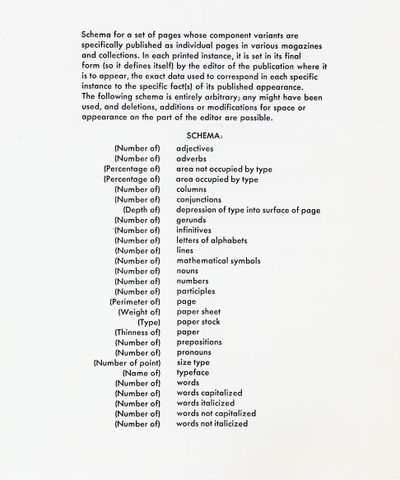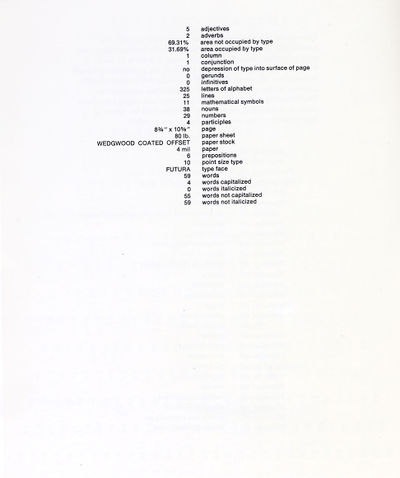User:Cristinac/unrulyobject: Difference between revisions
No edit summary |
No edit summary |
||
| Line 59: | Line 59: | ||
''Dan Graham | |||
''«Poem Schema» | |||
*«Schema for a set of pages whose component variants are to be published in various places. In each published instance, it is set in its final form by the editor of the particular publication where it is to appear, the exact data used to correspond in each specific instance to the specific fact(s) of the published final appearance. The work defines itself in place only as information with simply the external support of the facts of its external appearance or presence in print in place of the object.» (March 1966) (Source: Dan Graham, Art-Language, vol. 1 no 1, May 1969, p. 14, repr. in: Dan Graham, Works 1965–2000, Düsseldorf 2000, p. 95) | |||
[[File:schema1.jpg|400px]][[File:schema2.jpg|400px]] | |||
</div> | </div> | ||
Revision as of 18:17, 8 June 2015
- Jodorowsky's Dune/Fictional Computers
- The right to be forgotten
from Wikipedia:
"The right to be forgotten is a concept discussed and put into practice in the European Union (EU) and Argentina since 2006.[1][2] The issue has arisen from desires of individuals to "determine the development of their life in an autonomous way, without being perpetually or periodically stigmatized as a consequence of a specific action performed in the past."[3]:231 There has been controversy about the practicality of establishing a right to be forgotten to the status of an international human right in respect to access to information, due in part to the vagueness of current rulings attempting to implement such a right.[4] There are concerns about its impact on the right to freedom of expression, its interaction with the right to privacy, and whether creating a right to be forgotten would decrease the quality of the Internet through censorship and a rewriting of history,[5] and opposing concerns about problems such as revenge porn sites appearing in search engine listings for a person's name, or references to petty crimes committed many years ago indefinitely remaining an unduly prominent part of a person's footprint."
- Grey Media - Matthew Fuller
- Fountain
- Theft at Kunsthal
- Internodal – refusing to be indexed
- Kingdom of Lovely
- 'those missing from the stadium are always right', Paul Virilio 1982
- Patent Art
- House of Wisdom, Library of Alexandria
- International Corporation of Lost Structures
- disappearance as resistance
by Peter Weibel
- Noise, therefore, threatens information in several ways. The classic communication theory of information theory or cybernetics firstly simplified the problem of noise by excluding semantic problems, and secondly. viewed it naively, for example, by interpreting the observer not as a source of errors but as a corrector of errors. In a way, it represents a partial retrogression to the time before the thermodynamic theory of entropy. The approaches of quantum physics and chaos theory to information and entropy, as derived from thermodynamics, appear to me the most promising for neutralising the paradoxes and aporia of the theories of entropy and information, as exemplified by Maxwell's Demon, Szillard's machines etc. because they place the problem of the observer at the centre of attention. The noise of classical communication theory is more or less the noise of one's own signal, where the observer acts to correct errors. The noise in quantum physics is the noise of the observer, unavoidably and necessarily producing errors.
- The world is only ever defined at the interface between the observer and the rest of the world, Thus, the observer's position, is a regulator that can be moved on a frequency between paradise (information) and hell (error). Information is therefore unavoidably observer-relative. Of necessity the observer creates noise. He can escape this noise of observation only by himself becoming a part of the information model.
- Observation by an observer is, therefore, no longer sufficient to increase information; rather, what is required is an increased correlation and co-variance of observers and observations. It is questionable, however, whether we can grasp these correlations.
- Quantum physics has acquainted us with the fact that in observing systems and objects we must not dismiss the role of the observer. Niels Bohr promulgated the famous theory that the act of observation in turn influences the very object of our observation. Archibald Wheeler went even further by saying that a phenomenon is a phenomenon only if it is also an observable phenomenon. Here, the informedness of the observer is of central importance. A condition noted by the internal observer is different from that which "objectively exists" and can be observed from the outside. Quantum Demon therefore describes the problem of the noise-generating observer within information systems.
- A quantum theory of cultural theory is sorely needed. We must part with the traditional historical notion that there is a pure and objective description of the occurrences in the world of the mind, where the observer's contribution to the phenomena under observation can be disregarded or subtracted. We must take leave of this cliché and this illusion. For, on the contrary, in the world of the media in particular, Wheeler's Theorem applies that only an observed phenomenon is a true phenomenon. Only what is represented in the media also exists. and the form in which it exists in the data space equally depends on the position of the observer. Thus, the critic and the theoretician of culture act, willy-nilly, as real-life observers. The observed object's own signal becomes inseparably mingled with the observer's own signal or noise.
- Information and the observer can no longer be divided. The noise of the observer, the indeterminacy-relation between information and observer is not arbitrarily reducible. In the present world, in which, from medicine to economics, access to information and the spread of information are gaining an ever-more fundamental and central importance worldwide, the above-mentioned limitations are particularly noteworthy, since quite obviously there is a danger; firstly, of mistaking noise for information and, secondly, of not eliminating this noise with any increase in the amount of information, but of increasing it, in accordance with the theorem of quantum- and endo-physics, where the internal observer does not know that he is an observer and takes his own noise for the information from the situation under observation.
- But what, then, is the state of missing itself? Does it take place inside Schrödinger’s box, so to speak? Is it being both dead and alive? How can we understand its conflicting desires: to want and to dread the truth at the same time? The urge to both move on and keep hope alive? Perhaps the state of missing speaks of a paradoxical superposition that cannot be understood with the conceptual tools of Euclidian physics, human biology, or Aristotelian logic. Perhaps it reaches out to an impossible coexistence of life and death. Both are materially interlaced in limbo—as long as no observer opens the “box” of indeterminacy. Which is, in many cases, a grave.
- Additionally, the twentieth century also perfected observation as a method of killing. Measurement and identification became tools of murder. Phrenology. Statistics. Medical experimentation. Economies of death. In his lectures about biopolitics, Michel Foucault described the stochastic calculus that determined life or death.9 Counting and observing were radicalized to make sure that anything that entered the box died when the box was reopened.
Dan Graham
«Poem Schema»
- «Schema for a set of pages whose component variants are to be published in various places. In each published instance, it is set in its final form by the editor of the particular publication where it is to appear, the exact data used to correspond in each specific instance to the specific fact(s) of the published final appearance. The work defines itself in place only as information with simply the external support of the facts of its external appearance or presence in print in place of the object.» (March 1966) (Source: Dan Graham, Art-Language, vol. 1 no 1, May 1969, p. 14, repr. in: Dan Graham, Works 1965–2000, Düsseldorf 2000, p. 95)


